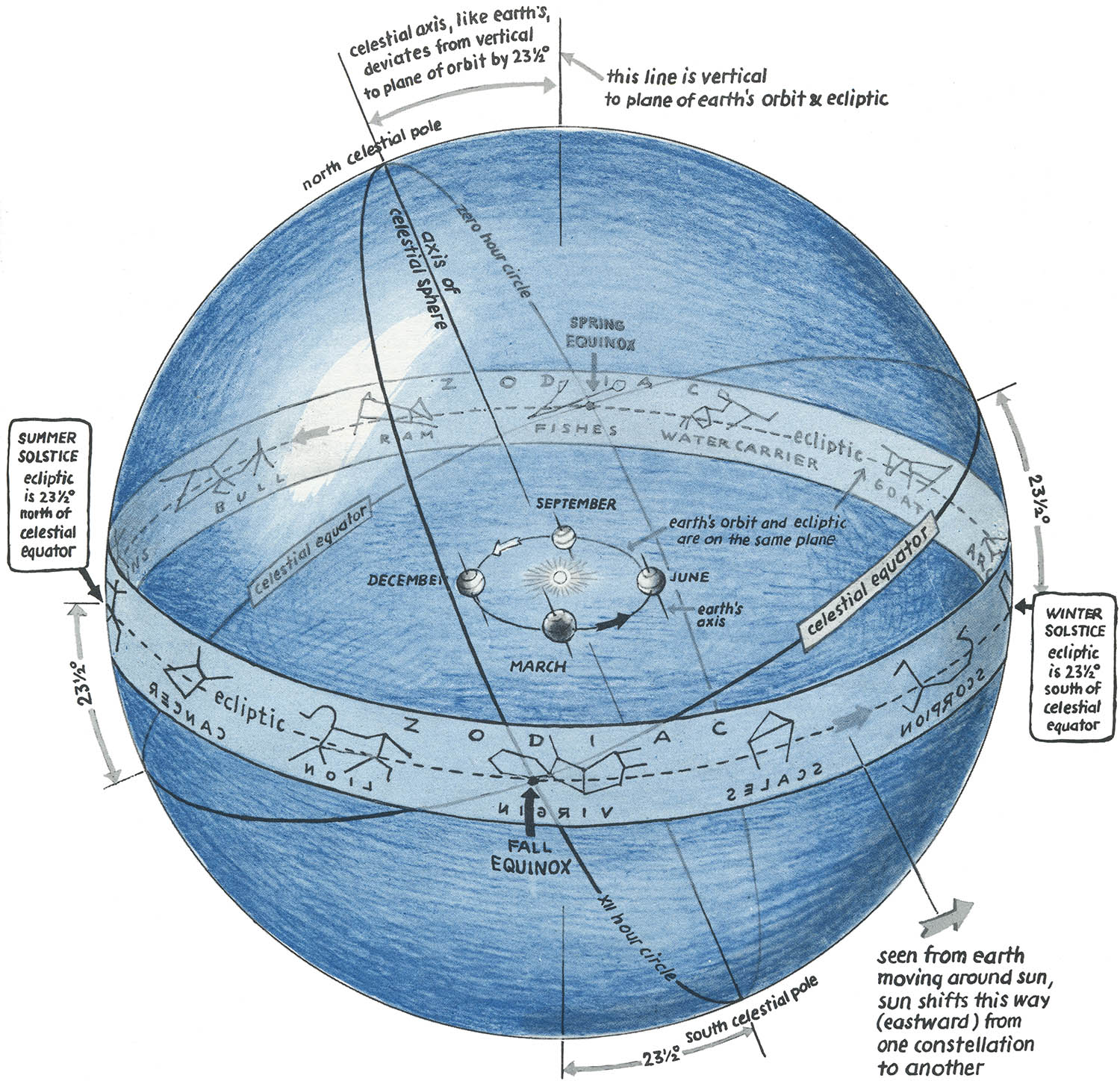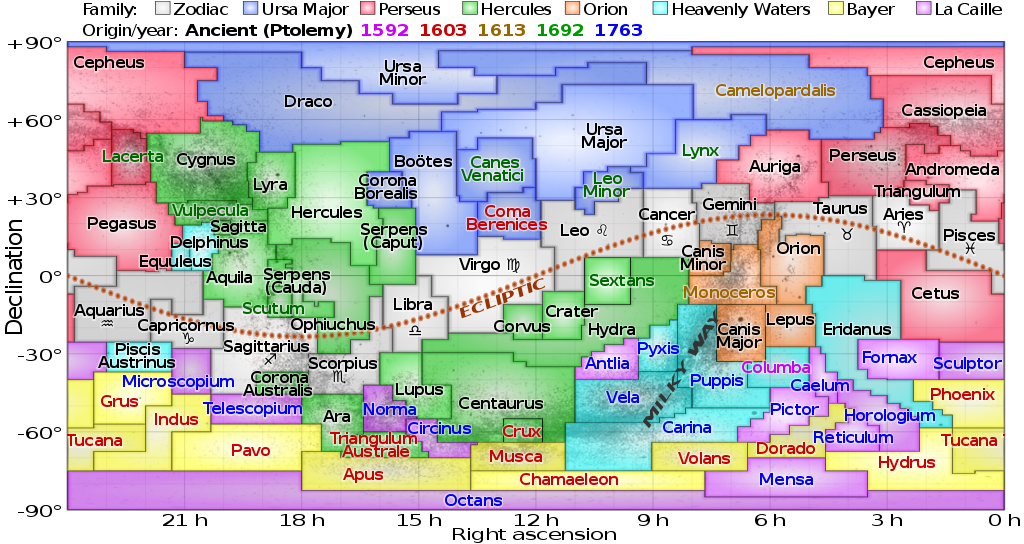Table of Contents
2. A tale of two spheres
“আকাশে সাতটি তারা যখন উঠেছে ফুটে আমি এই ঘাসে
বসে থাকি; কামরাঙা-লাল মেঘ যেন মৃত মনিয়ার মতো
গঙ্গাসাগরের ঢেউয়ে ডুবে গেছে—” – জীবনানন্দ দাশ
1. Two special spheres
Before we can find our place in the universe, we have to find a way to identify our position on earth and then identify specific directions toward the sky. Thus we have two spheres: the terrestrial sphere (earth) is real, the celestial sphere (the sky) is an imaginary sphere surrounding the earth. We can imagine all objects in the sky to be located on the surface of this celestial sphere, even though in reality they are not.

In this figure, the giant imaginary sphere is the celestial sphere and the tiny real sphere orbiting around the sun is the terrestrial sphere. Earth is orbiting on its axis. If you extend the axis up to the celestial sphere, you will get the axis of the celestial sphere. This axis also has a celestial north pole (NCP) and celestial south pole (SCP) define with respect to the north and south poles on earth. And, most importantly, if you extend earth’s equator up to the celestial sphere, you will get a circle called the celestial equator.
So much about the spheres. Now, how do we find our position on the surface of a sphere? For any astronomical observation, we have to, first, define our location on the surface of the terrestrial sphere (earth) and, then, identify the position of an astronomical object on the surface of the celestial sphere. The terrestrial and celestial positions are defined using a similar system.

On the surface of the earth, we define positions using latitudes and longitudes which are distances from two reference lines measured in angles. Latitude is measured from the equator, the circle perpendicular to earth’s axis. It can be up to 90 degrees above or below the equator. The north pole is 90 degree above the equator and the south pole is 90 degrees below the equator. Dhaka is 23 degrees above the equator. Latitudes are circles running parallel to the equator.
Longitudes are circles running perpendicular to the equator; they can be from 0 degree to 360 degree. Longitude is measured from a reference line going through the Royal Observatory Greenwich in the UK. So UK is at a longitude of 0 deg, whereas Dhaka is at a longitude of around 90 deg.
The directions in the sky are measured in something very similar to latitudes and longitudes. For every system of coordinates, we need two references. If you extend earth’s equator up to the celestial sphere, you will get one of the references for measuring celestial directions.
On the celestial sphere, the latitudes are called declination and the longitudes are called right ascension. The names have complicated origin and etymology which we will ignore here.
Declination can be from $-90$ deg to $+90$ degree, below and above the equator, respectively. The right ascension is from 0 to 360 deg, but it is sometimes given in hours. Earth rotates by 360 deg in 24 hours; so 24 hours is equivalent to 360 degrees; 1 hour = 15 degrees. Right ascension can thus be from 0 to 24 hours.
However, instead of finding the exact coordinates on the sky, we will use something called constellations for finding approximate locations on the celestial sphere.
2. Constellations and asterisms
A constellation is a group of stars that form a recognizable pattern when viewed from the Earth. These patterns were used for navigation by our ancestors and gave rise to numerous myths throughout human history. The patterns are of course imaginary. Some of the stars in a constellation might be very close to us, some might be extremely far from us.
Surface of the earth is divided into many countries and oceans. Similarly, the surface of the imaginary celestial sphere is divided into exactly 88 constellations. Although constellations began as collections of stars, they are now nothing but divisions on the celestial map.

This is a flat map of the sky, the surface of the celestial sphere. Note that you can actually make a flat map of earth’s surface even though the surface is round. Wrap a globe with a cloth, the cloth is now round. Now take off the cloth and lay it on a table, now the cloth is flat. So a flat projection of a round surface is totally possible.
On this flat map of the sky, the 88 constellations or divisions are clearly marked using different colors. The colors also indicate the historical period when that particular constellation was first officially recognized.
Compare this map with a world map with latitudes and longitudes. The horizontal axis would have longitude from 0 to 360 degrees, which is equivalent to 0 24 hours of right ascension. And the vertical axis would have the latitudes from -90 deg to +90 deg which is equivalent to the declinations given on the map above.
We identify people using their countries. Similarly, we identify stars, star clusters, nebulas and galaxies using the constellations in which they belong. For example, the Great Orion Nebula belongs to the Orion constellation.

Here you see a zoom into the sky map where Orion constellation is. Three stars (Alnitak, Alnilam, Mintaka) constitute the belt of the Orion. Betelgeuse and Bellatrix are the hands, Saiph and Rigel are the legs. Our ancestors devised a way to remember this region of the sky using the shape of Orion, a mythic hunter.
The map shows other prominent constellations, for example, Ursa Major and Ursa Minor. Use https://stellarium-web.org for exploring various constellations as shown below.
Asterism
Sometimes smaller patterns are imagined inside larger constellations. These patterns within a given constellation are called asterisms. For example, Big Dipper (সপ্তর্ষি মণ্ডল) is an asterism of 7 stars within the constellation Ursa Major.

In this famous painting by Vincent van Gogh, you see a depiction of the Big Dipper. This asterism might have already captured the imagination of human cultures 50,000 years ago.
3. Zodiac
Twelve of the 88 constellations are special because the Sun is seen on the foreground of these constellations in a given year. These 12 constellations form the zodiac. Sun travels from one of the zodiac constellation to another every month, twelve constellations are traversed in twelve months.
To understand this phenomenon, try to remember what we did in the class. Remember that the table-top was imagined to be the plane of our solar system. The sun was in the middle of the table and the half-lighted globe was orbiting around the sun. Twelve students representing the twelve zodiac constellations were standing around the table. I was standing near the earth. From where I was standing on the earth, I would see the sun near the constellation that falls on the line joining the earth and the sun. This is our line of sight. As the earth rotates around the sun, this line goes from one constellation in the zodiac to the next.
This change of position of the sun can be seen more clearly from this animation: https://astro.unl.edu/naap/ssm/animations/configurationsSimulator.html as seen in the following video.
In this video, the blue dot is the earth and the red dot is the sun; do not worry about the grey dot. The line joining the earth and the sun has an arrow at its end. This arrow indicates the position of the sun with respect to the earth during different months in a year. As the earth revolves, the arrow points toward different directions, toward different constellations in the zodiac. And the resulting change in position of the sun with respect to the distance stars of the constellations can be seen in the snippet at the very bottom of the video.
Within a given year, the sun moves from Sagittarius (west) to Scorpius (east) and then comes back to Sagittarius. From Sagittarius to Scorpius, the sun is seen near Capricorn, Aquarius, Pisces, Aries, Taurus, Gemini, Cancer, Leo, Virgo and Libra.
One question remains though. Why do see the sun only near these 12 zodiac constellations and not near the other 66 constellations?
The answer lies in the shape of the solar system. Our solar system is flat; all planets and small objects orbit around the sun on a single plane. So, we will not see the sun if we look directly toward north or south from earth; only emptiness and other distant stars lie in those directions. But sun is seen when we look from east to west. Not only the sun, almost all other objects in our solar system also appear along the same line from east to west. This line in the sky is nothing but the plane of our solar system seen edge-on.
4. Seasonal constellations
From the solar system now let us divert our attention to the constellations themselves, specially the other 66 constellations. Can we see all of these constellations every night?
The answer is no. Go back to the 12 angry students standing around the table with the sun (a bright bulb) and the earth (a globe) on the table. The students are the constellations. When the earth is on the northern side of the table, the sun is toward the south, and the zodiac constellations on the southern side cannot be seen during nighttime. This is because the southern side of the table is toward the day-side of earth and the stars in that direction cannot be seen due to sunlight. On the other hand, the northern side of the table is toward the night-side of earth and, hence, stars in that direction can be seen during nighttime.
So during different months of year, not only the sun changes its apparent position with respect to the zodiac constellations, but also different constellations appear in the night-sky. This has been shown in the following video made using https://stellarium-web.org.
In this video, we start with the complete sky (one complete hemisphere) on 1 Jan 2023. As the month is changed, you see that the whole sky is shifting from east to west, because the earth is revolving around the sun and different constellations are appearing on the night-side of earth. The names of the constellations are not shown, only their traditional historical symbolic drawings.
Everything changes except the north pole and the star near the north pole, the Polaris (ধ্রুবতারা), does not move much throughout the year. This is because the earth is revolving around the sun on a single plane and the north pole of earth keeps pointing toward Polaris throughout the year.
In the following table, the main attractions on the sky are mentioned for the four seasons.
| The heavenly attractions of different seasons in the northern hemisphere | |
|---|---|
| Autumn | Polaris, Cassiopeia, Andromeda, Great Square of Pegasus, Milky Way, Perseus, Northern Cross in Cygnus, Vega in Lyra, Hercules. |
| Winter | Pleiades and Hyades in Taurus, Orion, Sirius in Canis Major. |
| Spring | Disappearing Hyades and Orion signal spring, Castor and Pollux in Gemini, Ursa Major overhead in evenings, Regulus in Leo, Arcturus in Bootes, Spica in Virgo, Hercules. |
| Summer | Antares in Scorpius, Vega near zenith, Hercules, Sagittarius and the Galactic Center, Perseid meteor shower on August 12, variable $\delta$ Cephei in Cepheus. |
Explore stellarium and find out more for yourself.
Orion is the most prominent constellation from Bangladesh during Spring. So we will focus on Orion throughout the semester.